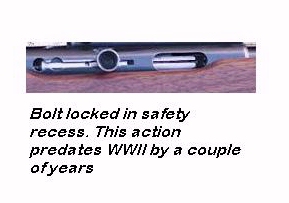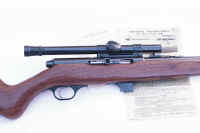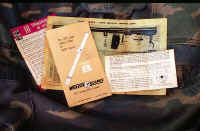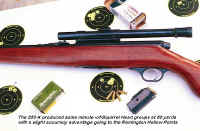The Mossberg / New Haven Model 250 K
click on any image for a larger photo.
Interesting things lurk in the dark recesses of Baby Boomer closets and the forgotten corners of post war, two car garages now gone to seed. A recent foray into just such a remnant of Beaver Cleaver Land brought forth a pristine example of Kennedy Era memorabilia in the form of a New Haven Model 250K, complete with original paperwork and mounted with the Weaver B4 rimfire rifle scope of fond and distant memory.
The rig had been bought at Waco Hardware forty years before and apparently put away without even a single box of .22s being launched into the walls of the near-by gravel pit or the carcasses of various jackrabbits, cottontails and armadillos- abundant before the fire ants came.
The rifle bore a strong resemblance to the Mossberg semi-autos -versions of which pre-dated WWII and persisted through out the middle decades. It was in fact a proprietary version of the Mossberg 152K clip fed seven shot repeater found in the 1955 edition of Gun Digest (parts presently catalogued by Numrich Gun Parts). The O. M. Mossberg firm was a prime supplier of rifles for the various chain stores and the New Haven was one such example. It appears in the Gun Digest dated 1961 - a contemporary of such classics as the Remington Nylon 66, the Winchester 77 and the Ithaca Lightning Take Down. The posted price was $37.95 which factors out to about $225 in today’s currency.
The B 4 sight was a child of the ‘50s, identical to the example that adorned my first rimfire rifle - a bolt action “ Western Field” made by Mossberg for the Monkey Wards chain. In 1961, it cost $9.50 or about $35 at the present rate.
The 250K is stocked in well-figured walnut with the excellent overall fit and finish that were taken for granted before the general degradation that ran through the firearms industry in 1964. The B 4 had the much- desired “Tip Off Mount” on the grooved receiver and was possessed of a steel and not an alloy tube. As a unit, this rig was highly evocative of the time with many similarities to the general run of rimfire rifles in the post-war era-the rifles that its current owner, Louis Ellis, and I cut our teeth on.
In 1961 we would have gone to the gravel pit, laid the rifle over the hood of a car, sighted in on a beer can at a randomly selected distance and thereafter concentrated on the important stuff such as plinking and decimating the varmint population. Now, we would proceed in a more orderly fashion with a view to finding out what this anachronistically like-new relic of our youth would really do. Ellis had already done a preliminary sight-in with CCI Mini-Mag Hollow Points. He shot a couple of 25 yard three round groups of about half an inch and also laid in a 1” three shot group with the same load at 50 yards. The Mini-Mags functioned without a bobble. We set up on the 50-yard bench using a fairly rigid but makeshift rest and got serious with three five round groups each of Federal Match, Remington High Speed Hollow Point and CCI Greentag.
As frequently occurs with sporting arms of the non-target variety, the high-speed hollow point actually shaded the target rounds in the accuracy department. This is a Trans sonic load producing measured velocities from just under 1100 fps to about 1150. This velocity range has popularly been considered less productive of overall accuracy than that of the clearly sub-sonic target loads. Nevertheless, we recorded groups of .76”; .85”. and 1.4” for an average of exactly one-inch for the fifteen rounds. The fly in the ointment was the occasional failure to feed/eject hollow points, but this was absent in the shooting of the “solid” target loads or the previous Mini Mag HPs. Federal match clocked in the low to mid 1000 fps range and turned in groups of 1.18” 1.18” and .96” with a 1.1” average. The CCI Greentags were in the low 1,000 fps range and grouped .98”; 1.7”; and 1.3” averaging slightly over 1.3” overall.
We reflected that two of the three loads had provided squirrel-head accuracy at 150 feet which we considered quite good. We also opined that the overall accuracy would have been a bit better if we had been locked into a truly state of the art shooting rest instead of rolled up carpet remnant.

We found the New Haven a nice piece of human engineering. The safety arrangement is unique to the Mossberg line. Engaging the safety involves retracting the slide and pressing the bolt handle into a round cutout in the receiver. This retracts the bolt (and chambered round), locks the bolt in place and disconnects the trigger all in one fell swoop. The safety is released by pulling out the bolt handle and letting go or simply by brushing it outward with the right thumb. The action does not remain open after the last round but full bolt retraction can be accomplished by pushing the handle into another round cut near the back of the receiver.
The hold open feature proved useful in an important segment of our range work. We checked out the 250K with the extremely useful CCI Long Mini-Cap. The 29 grain bullet exits the New Haven at just over 600 fps producing a gentle “clack” upon firing and a satisfying “whap” as it impacts various urban and suburban targets of necessity. It is less obstreperous in the noise signature department than most air rifles while delivering quite a bit more in the way of down-range impact. Recoil impulse is weak and generally leaves the empty case stuck in the action of almost all semi-auto rifles. (An exception is the old Remington floating chamber model which functions with Shorts Longs and Long Rifles and will even function in the rapid fire mode with the CCI version of the CB Cap.)
The caps turned in a 1.4” 25 yard group about an inch low and left on the target. Be careful with these. They are destructive beyond what would be expected from their suppressed report and relatively sedate velocity. As with the more potent rounds, a positive backstop is a necessity. Both the long and short versions of this load will shoot into an inch and under from my Remington 521 T and the shorts variation achieves 700 fps from that rifle.

In casual off-hand shooting, Ellis managed to put five consecutive shots into a three- inch Birchwood Casey yellow flash target at 25 yards. I myself missed it a couple of times. The trigger pull, while light, exhibits considerable take up and emits a distinctive “ping” slightly before let-off. There is considerable over-travel after the shot is away. Minor quibbles aside, the 250K is a nifty field piece. Likewise nifty is the Weaver B 4 rimfire scope pictured above. It got little respect in its day. Everybody wanted a copy of the J 4 .22 Hornet scope for his .22. the J series was a bit better at light transmission, had a slightly wider field of view and a somewhat longer range of optimum eye relief. Nevertheless, our present shooting exercise and the memory of many demised small game and varmints is testament enough to its now long gone goodness.
The New Haven 250 K is not just a nicely made relic of a bygone day. It holds its own with the mass market rimfires of the present day and is of such quality that it would probably cost a fortune to produce in the present era.
since the website crashed AUG 2003, original
publish date was 11-19-2001


